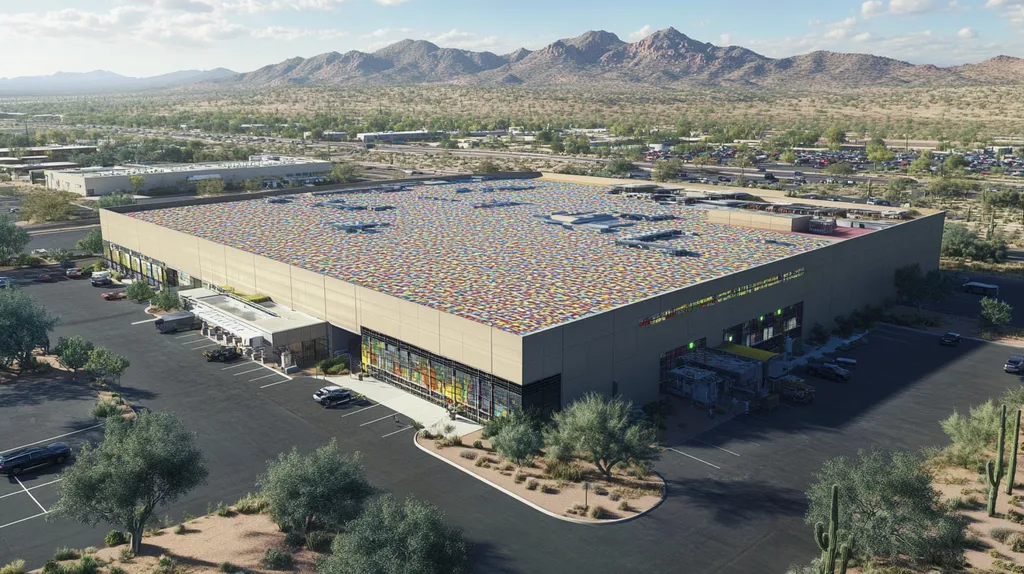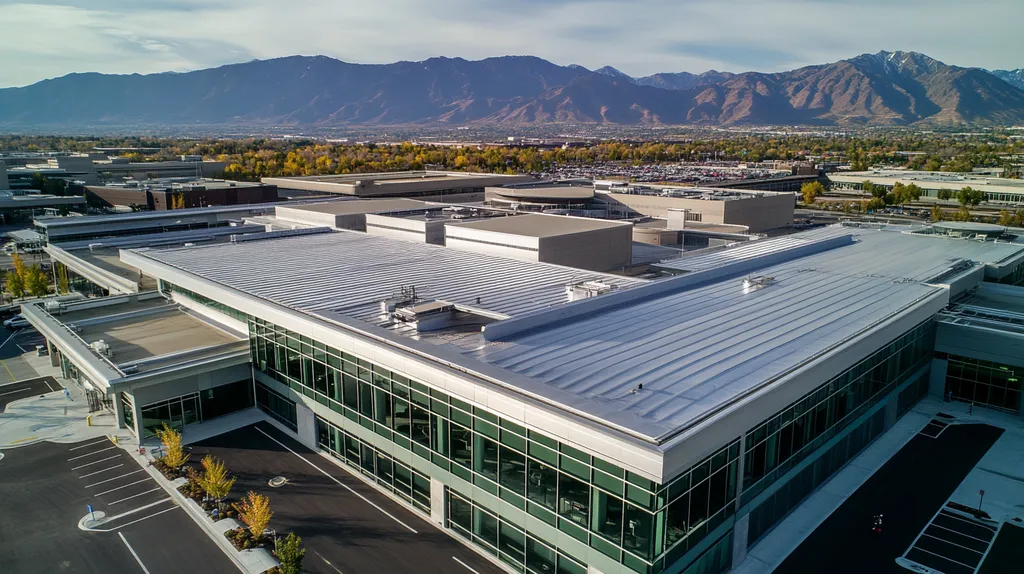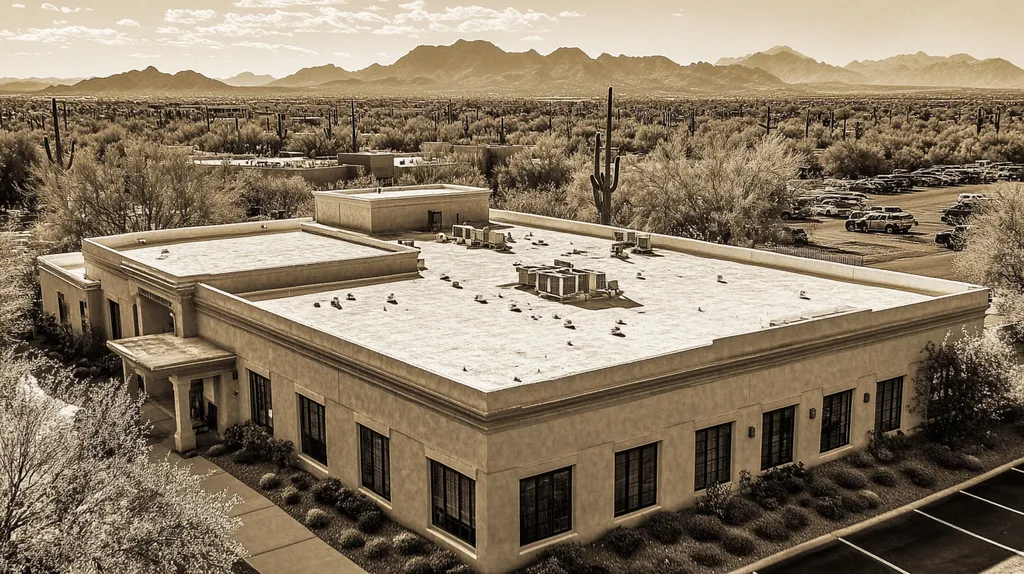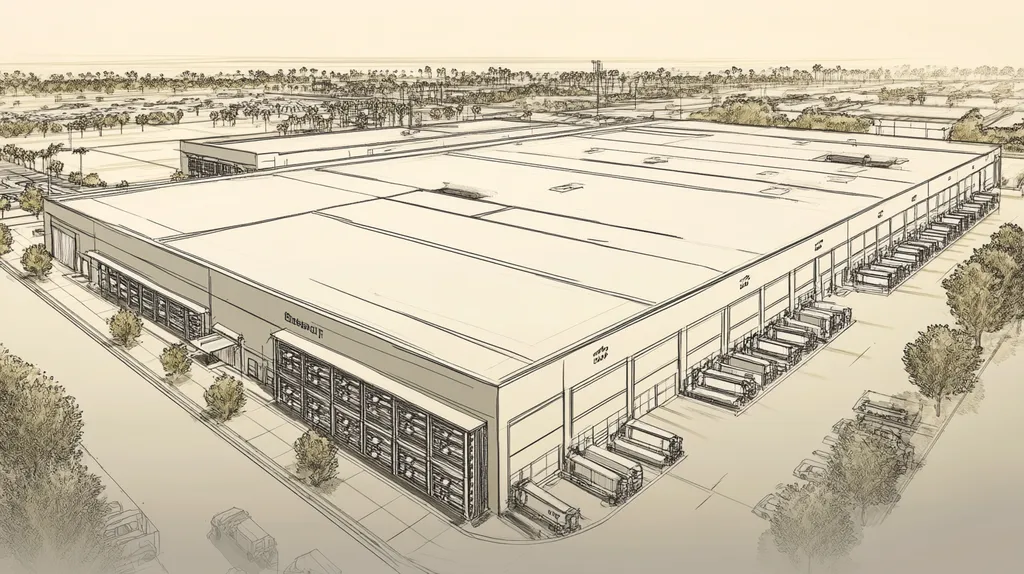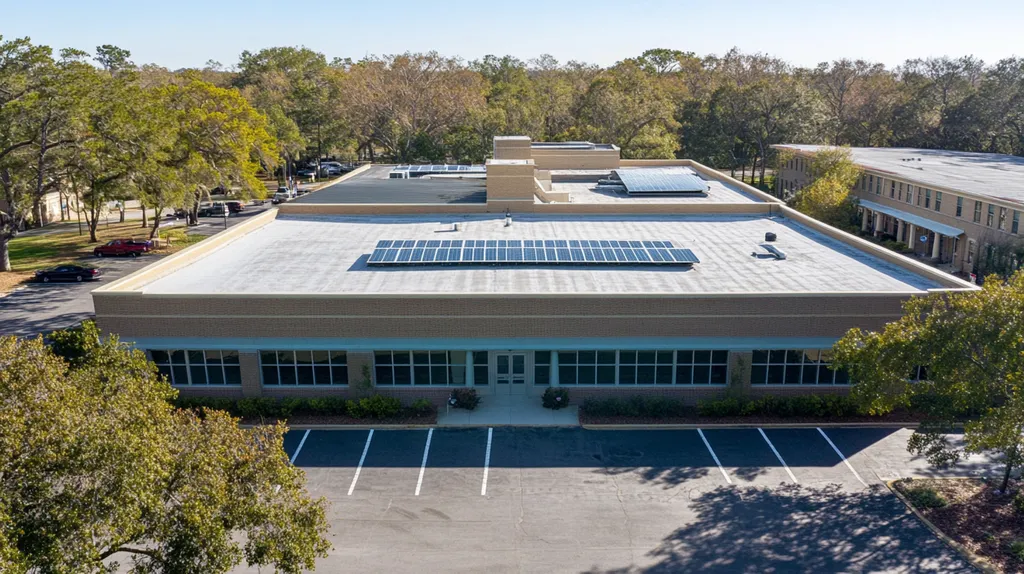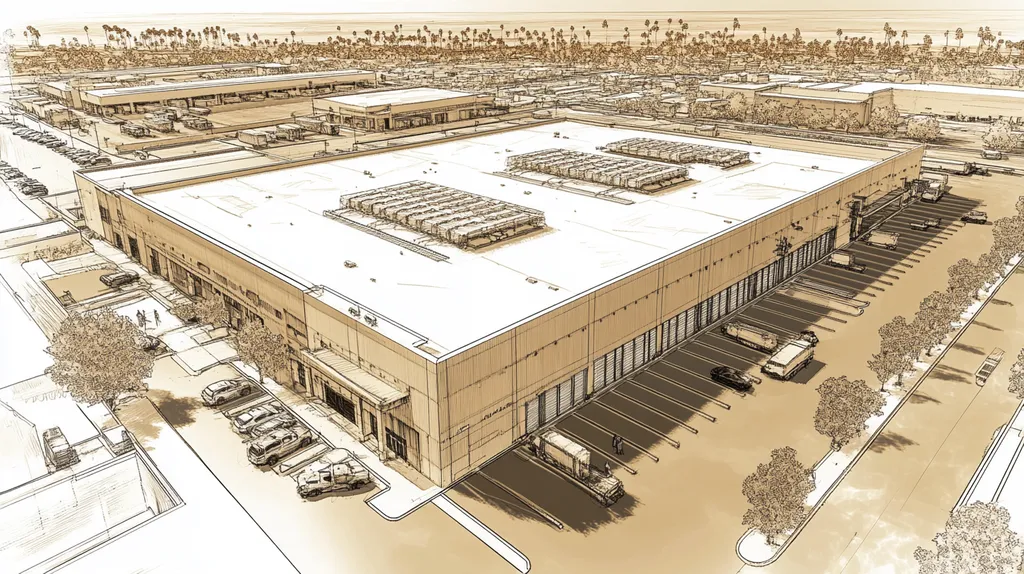The commercial roofing industry’s rush toward eco-friendly materials has created an environmental paradox. While sustainable roofing sales have surged 47% since 2020, mounting evidence suggests many “green” options actually increase carbon footprints and maintenance costs.
From production emissions to premature material failures, the hidden costs of eco-friendly roofing continue mounting. Recent studies indicate that up to 30% of sustainable commercial roofs require replacement within 10 years – twice the rate of traditional materials.
This analysis exposes the systemic issues plaguing current eco-friendly options while highlighting promising alternatives that deliver genuine environmental benefits without compromising performance.
SECTION 1: CURRENT PRACTICES
The roofing industry is under immense pressure to embrace eco-friendly materials, with projections suggesting that sustainable roofing could represent over 30% of the commercial market by 2025. Yet, property owners and facility managers must tread carefully. Many of the so-called “eco-friendly” materials may not actually provide the promised benefits, whether in terms of environmental impact or long-term durability. Navigating the complexities of these materials is essential for making enlightened choices that meet sustainability ambitions while balancing budgets.
Popular Eco-Friendly Materials
When it comes to eco-friendly roofing materials, green roofs, solar panels, and reflective coatings often take center stage. Green roofs can create stunning visual landscapes, but they come with hefty structural demands and ongoing maintenance needs that can quickly spiral into unexpected expenses.
Solar panels are another trending option, yet their performance can vary considerably based on location and weather patterns. For instance, in areas plagued by clouds, solar installations might deliver fewer energy savings than hoped, leaving property owners in the dark about their investments.
Reflective coatings shine in marketing as solutions for reducing heat absorption and slashing cooling costs. However, the narrative often glosses over their actual longevity and reliability. If applied poorly, these coatings can peel away and underperform, leading to escalating maintenance costs over time.
In essence, while these materials are often hailed as eco-friendly heroes, a discerning approach is vital to ensure they genuinely suit the specific needs of a property and contribute to environmental goals.
Installation and Maintenance Standards
Installation and maintenance guidelines for eco-friendly roofing materials remain frustratingly vague. This lack of clear protocols can result in improper installations, ultimately compromising performance and sustainability. For example, a green roof that’s installed incorrectly may become a breeding ground for drainage issues, hastening its demise.
Maintenance requirements for these materials also vary widely. Living roofs, for instance, demand consistent care that not every facility manager may be equipped to provide. Neglecting these needs can trigger higher long-term expenses and potential damage to the structure, defeating the purpose of the eco-friendly investment.
Unfortunately, industry standards for installing eco-friendly materials tend to lag behind those for traditional options. Without strong guidelines, the risk of low-quality work increases, which can inexorably undermine the anticipated benefits. Poor installations not only waste money but also threaten sustainability initiatives.
Thus, property owners and facility managers must actively pursue best practices in installation and maintenance to ensure that eco-friendly materials perform as promised and stand the test of time.
Industry Trends and Adoption Rates
Despite the increasing calls for eco-friendly roofing systems, adoption rates reveal a disconcerting reality. Recent surveys show that only around 20% of commercial buildings are currently equipped with sustainable roofing options. This slow growth raises eyebrows about the industry’s genuine commitment to sustainability.
Several hurdles contribute to this trend, including the perceived costs associated with eco-friendly installations and a general lack of understanding regarding their long-term benefits. Property owners often hesitate to invest, fearing immediate financial returns may not materialize. This hesitation can lead them to stick with outdated traditional roofing systems, missing vital opportunities for sustainability.
As awareness around eco-friendly materials grows, so does the perception of their value. With more emphasis on building certifications like LEED, property owners are beginning to explore sustainable options during the planning stages. Yet, confusion still reigns about which materials deliver the true environmental benefits they claim.
This disconnect between awareness and actual adoption underscores the need for greater clarity around eco-friendly roofing choices. As the industry evolves, staying informed about current trends and new products becomes crucial for property owners looking to make responsible, forward-thinking roofing decisions.
SECTION 2: SYSTEMIC ISSUES
The push for eco-friendly commercial roofing materials can feel like a valiant quest for sustainability, but lurking beneath the surface are systemic issues that threaten to undermine that very mission. Such materials often come with unintended consequences, from environmentally harmful production processes to durability concerns that could lead to costly repairs. In this section, we dive into the hidden challenges that haunt green materials, exploring their lifecycle emissions, performance limitations, and the financial hurdles faced by property owners.
Environmental Impact of Production
A surface-level glance at eco-friendly roofing might lead one to believe they’ve hit the jackpot of sustainability. However, many materials boast “green” labels while still relying on environmentally questionable production techniques. Take rubber roofing, for instance; hailed as a sustainable option, it can emerge from petrochemical processes that belch out pollutants into our atmosphere.
Then there’s the raw material extraction for certain green insulation products, which often wreaks havoc on ecosystems, driving land degradation and putting biodiversity at risk. In fact, studies have shown that when you consider the entire lifecycle of some so-called eco-friendly materials, their greenhouse gas emissions can exceed those of traditional roofing alternatives.
It’s vital for property owners to look beyond marketing fluff and consider the full picture—from how materials are made to whether they can be effectively recycled. If decision-makers overlook the production and disposal phases, they might find themselves sandwiched in a green façade, facing unexpected consequences later.
A holistic view of sustainability is non-negotiable; otherwise, the push for greener buildings could be nothing more than a pretty charade.
Limitations in Durability and Performance
Diving deeper into roofing choices, one must face the reality that durability is often sacrificed at the altar of eco-friendliness. Many green products are designed with sustainability in mind but frequently lack the long-lasting qualities of their conventional counterparts. For example, some plant-based roofing solutions may offer decent insulation but crumble under the pressure of inclement weather.
This lack of resilience can snowball into expensive repair and replacement costs down the line, effectively nullifying any upfront savings from opting for eco-friendly materials. In climates where extreme weather is the norm, a roofing system that can’t withstand Mother Nature’s fury is more than just a poor investment—it’s a structural risk.
Further complicating the matter is the performance of these materials. If they can’t manage temperature swings or meet insulation demands effectively, they undermine energy efficiency, increasing operational costs where they should be decreasing. Property owners need to weigh performance and durability equally alongside sustainability options. Ignoring these factors can lead to higher costs and risk to the integrity of the building.
Cost and Availability Challenges
The financial narrative surrounding eco-friendly roofing choices is often more complex than marketing materials let on. While many eco-friendly products carry an alluring green label, they typically come with a higher price tag due to advanced manufacturing processes or limited production. The inclusion of specialized installation techniques can also crank up labor costs, mandating a serious budgeting review.
Limited availability ramps up the complexity. Many eco-friendly materials aren’t mass-produced, leading to supply chain bottlenecks. In a squeeze, property owners might face delays or feel pressured to pay inflated prices for speedy deliveries, compromising their sustainable vision at the expense of convenience.
That’s not all; it’s equally important to consider cumulative costs over the lifespan of a roof. Factors like maintenance and energy efficiency must be balanced against those initial outlays. Surprisingly, traditional materials might offer better returns while still ticking the sustainability box.
Ultimately, stakeholders in the roofing industry need to bridge the gap between first impressions and long-term costs linked to eco-friendly materials. Clarity on financial implications is crucial to avoid budget-busting surprises while still meeting sustainable building goals.
SECTION 3: MISSED OPPORTUNITIES
As property owners scramble to make greener roofing choices, they often overlook some promising materials and systems that could elevate both sustainability and financial savings. Ignoring these opportunities not only hampers environmental goals but also keeps potential profits at arm’s length. Various misconceptions about innovative solutions can block the adoption of advanced roofing materials that enhance performance. This section shines a light on the sustainable materials that deserve attention, the advantages of hybrid systems, and the often-overlooked potential of recycling in the roofing world.
Overlooked Sustainable Materials
Despite the growing awareness of eco-friendly options, many property owners stubbornly cling to conventional roofing materials. What they may not realize is that innovative alternatives like bamboo and recycled rubber are not just durable but also an eco-conscious choice. Take bamboo, for example: it’s a fast-growing resource that significantly reduces carbon footprints and adds a modern twist to any building.
Don’t forget reclaimed materials, either. Products like composite shingles are crafted using post-consumer waste and often come with a lower price tag, all while fostering a circular economy. These overlooked options offer enormous environmental benefits along with potential tax credits, which can translate into substantial savings for savvy property owners.
By broadening their horizons and considering these advanced materials, property owners can tap into a wealth of financial and ecological advantages. It’s all about making informed choices that not only boost a building’s market value but also enhance its appeal in the ever-competitive landscape.
Neglected Benefits of Hybrid Systems
When it comes to maximizing performance, hybrid roofing systems often lay on the sidelines, ignored by decision-makers. A striking example is combining solar panels with traditional roofing materials. This smart partnership allows roofs to harness energy while maintaining structural integrity, effectively generating power—talk about a multitasker!
Hybrid systems can also elevate insulation performance. A roof featuring both metal and insulation can significantly drive down energy consumption, particularly during extreme weather conditions. However, these systems do come with a higher upfront cost, which often leads to hesitation.
Facilities management must take a broader approach and analyze the total cost of ownership, encompassing maintenance and energy efficiency over time. By skipping over hybrid options, property owners not only miss out on energy savings but also pass up possible rebates for implementing energy-efficient technologies. Embracing hybrid systems is crucial for reaping the full rewards of sustainable roofing.
Untapped Potential in Recycling
Recycling old roofing materials is like striking eco-gold, yet it remains an underutilized opportunity in the commercial roofing sector. Many owners underestimate that dismantled roof materials can be effectively repurposed. For instance, asphalt shingles can be recycled into new roofing products, significantly cutting down landfill waste.
Though some states have established recycling programs, participation rates are dismally low. Property owners overlooking recycling not only face higher disposal costs but also contribute to unnecessary environmental strain, creating a double whammy of regret.
Setting up a recycling program isn’t just a good practice; it’s a marketplace advantage. Highlighting a commitment to sustainability can boost a building’s reputation and draw eco-friendly tenants. The ability to reduce costs tied to roofing projects makes recycling not just a noble endeavor but a financially savvy choice as well.
Incorporating recycling into roofing strategies is a pivotal way for commercial property owners to align their operations with sustainability goals, assuring benefits for both the planet and their wallets.
SECTION 4: ROOT CAUSES
Understanding the root causes of the shortcomings in eco-friendly roofing materials is critical for property owners and managers. While many assume that green materials are inherently sustainable, the truth reveals a web of hidden pitfalls. By digging into issues like resource extraction, the absence of standardized metrics, and regulatory shortcomings, we can better grasp why common misconceptions persist. Identifying these root causes enables informed decision-making that genuinely aligns with sustainability objectives.
Resource Extraction and Energy Consumption
The green scene might seem bright and shiny, but the production of eco-friendly roofing materials often casts a shadow. Many so-called sustainable options still rely on intensive resource extraction, leading to habitat destruction and elevated carbon emissions. Take the mining of recycled metals, for example—it can unleash more pollution than the very traditional materials they’re trying to replace.
Additionally, the energy consumed in manufacturing these so-called green products can be staggering. Products branded as eco-friendly may come with hefty energy footprints tied to industrial processes. This inconvenient truth can easily erase their supposed environmental perks, leaving property owners scratching their heads.
To make smarter choices, property owners must look beyond the marketing hype and closely examine a material’s life cycle impacts. A rigorous life cycle assessment can lay bare the alarming truths about energy consumption and emissions associated with these products.
Ultimately, roofing material choices should encompass the complete supply chain narrative to avoid merely trading one environmental headache for another.
Lack of Standardized Sustainability Metrics
Selecting eco-friendly roofing materials can feel like wandering through a maze—primarily due to the absence of universally accepted sustainability metrics. This gap fuels confusion and misinformation within the industry. Some companies proudly tout their products as “green,” despite not adhering to consistent standards or certifications.
Without standardization, property owners struggle to make fair comparisons between different materials. For instance, one product might claim to be environmentally friendly but lacks third-party validation, while another boasts a comprehensive sustainability profile.
To enhance informed decision-making, the industry needs a concerted effort to establish and enforce robust sustainability criteria. These standards would create a clearer framework for product evaluation, considering factors like energy consumption, recycling potential, and overall environmental impact.
Until these metrics are standardized, property owners should approach their selections with caution and conduct thorough research before committing to any eco-friendly materials.
Regulatory and Policy Gaps
The regulatory landscape for eco-friendly roofing materials is often a patchwork quilt of inadequacies and inconsistencies. This lack of robust policy gives manufacturers the latitude to make misleading claims about their sustainability. In unregulated waters, greenwashing thrives—where products appear eco-friendly without any substantial backing.
This spells big trouble for commercial property owners. Opting for roofing materials based on deceptive marketing can lead to long-term financial woes and environmental fallout.
Addressing these regulatory gaps demands collaboration among industry stakeholders, policymakers, and environmental advocates. Together, they can champion more stringent regulations that prioritize true sustainability and accountability.
Until then, property owners face an uphill battle in a marketplace riddled with unreliable options.
DATA DRIVEN EVIDENCE
In the race toward sustainability, many commercial property owners are blissfully unaware of the critical data that should inform their choices for eco-friendly roofing materials. Some options often lauded for their green credentials may actually have a larger carbon footprint than traditional alternatives. Making uninformed decisions risks not only significant financial setbacks but also environmental harm that could have been avoided.
Carbon Footprint Comparisons
Assuming that eco-friendly always equates to low carbon impact is a dangerous gamble. Take PVC roofing, often hailed for its ‘green’ status; research suggests its production can emit more greenhouse gases than traditional asphalt. It’s a classic case of greenwashing where the surface glitters, but the underlying impact is tarnished.
A thorough life-cycle analysis (LCA) is essential in this equation. It’s not just about emissions during production; consider transportation and disposal as well. A material that appears eco-friendly on the surface may, when fully vetted, reveal a hideous carbon footprint by the end of its lifecycle.
Utilizing data-driven comparisons empowers property owners to sift through the marketing fluff and pinpoint materials that genuinely contribute to environmental progress. Tools like the Environmental Product Declaration (EPD) facilitate straightforward side-by-side evaluations, making informed decisions less daunting.
In a marketplace rife with misleading claims, leveraging detailed carbon footprint data isn’t just clever; it’s essential for making choices that are both environmentally responsible and economically sensible.
Lifecycle Cost Analysis
If property owners truly want to grasp the financial implications of eco-friendly roofing, they must engage in a comprehensive lifecycle cost analysis (LCA). Too often, the focus remains squarely on initial installation costs, blinding decision-makers to the ongoing expenses associated with maintenance, energy savings, and eventual disposal.
For instance, reflective roofing materials may promise substantial energy savings. Still, they could come with steeper installation and maintenance costs compared to conventional materials, shifting the financial equation entirely. In some cases, traditional roofing alternatives can provide better long-term returns, making them the unexpected champions.
Case studies illustrate this pitfall vividly. A facility chose what it thought was a green roofing system based solely on upfront costs but found itself drowning in ongoing maintenance fees shortly thereafter. Without a full LCA, the intended environmental benefits likely evaporated into thin air.
Integrating lifecycle cost analysis into material selection will safeguard against unwelcome surprises and support smarter, sustainable investments in roofing.
Case Studies of Sustainable Roofing Failures
Real-world blunders reveal that sustainable roofing choices don’t always deliver as promised. Consider a city facility that installed a living roof expecting significant energy reductions, only to find itself grappling with maintenance woes, leaks, and hefty repair costs shortly afterward.
Another example involves a company that picked a bio-based roofing material, which came with green marketing accolades. Unfortunately, the product failed to perform as expected, deteriorating faster than warranted and necessitating premature replacement.
These cautionary tales underscore the need for thorough investigations into the long-term performance and implications of any chosen material. A meticulous review of failures can unveil valuable lessons that help prevent future mistakes.
By scrutinizing case studies and feedback from similar projects, property owners can avoid repeating the same pitfalls. Ultimately, selecting the right roofing material requires much more than reliance on green marketing claims; it demands careful analysis and strategic foresight.
SECTION 6: ALTERNATIVE SOLUTIONS
As the demand for eco-friendly roofing spikes, property owners confront the urgent task of reassessing their material choices. Too often, conventional eco-friendly options fall short on performance and longevity. Fortunately, innovative materials and technologies are stepping into the spotlight, offering effective alternatives that boost sustainability while maximizing performance. Exploring these breakthroughs might just unveil new avenues for building owners desperate for better solutions. This section will delve into cutting-edge materials, advanced technologies, and integrated systems.
Innovative Material Choices
Traditional eco-friendly materials, like certain recycled products, can falter in diverse climate conditions. That’s where new innovations in roofing materials enter the fray. Thermoplastic polyolefin (TPO) and polyvinyl chloride (PVC) are gaining traction due to their impressive energy efficiency and durability.
These materials reflect solar energy, curbing heat absorption. This characteristic is especially advantageous in urban areas, where heat islands amplify cooling demands. By opting for materials that keep buildings cooler, property owners can dramatically reduce energy bills.
Additionally, advancements in biobased roofing options are opening up exciting possibilities. Made from renewable resources, these options strike a compelling balance between sustainability and performance, serving as favorable alternatives to conventional petroleum-based systems.
By embracing these innovative materials, property owners can make informed selections that not only support environmental goals but also enhance cost efficiency.
Advanced Roofing Technologies
Beyond smarter materials, technology is revolutionizing approaches to commercial roofing. Enter smart roofing technologies—now essential components of modern systems. These roofs come equipped with sensors that track temperature, humidity, and moisture levels.
This capability facilitates proactive maintenance, minimizing the risk of leaks and structural damage. Data analytics help property managers extend roof lifespans and optimize performance, ensuring that roofs do more than just sit overhead.
Moreover, integrating roofing with energy-efficient technologies like photovoltaic panels enhances building energy management. This dynamic combo not only cuts energy costs but also aligns with the sustainability certifications that increasingly matter to stakeholders.
Advanced roofing technologies are bridging the divide between traditional practices and eco-friendly innovations, keeping property owners ahead of evolving demands.
Integrated Sustainable Roofing Systems
Integrated sustainable roofing systems provide a holistic approach to eco-friendly roofing. These systems combine a variety of elements—insulation materials, advanced drainage solutions, and vegetation layers—creating a cohesive solution that excels in energy performance and longevity.
For instance, green roofs elevate energy efficiency while delivering aesthetic and ecological benefits. They also manage stormwater with finesse, reducing runoff and easing the burden on municipal systems.
By embracing an integrated strategy, property managers can achieve deeper sustainability goals that resonate with contemporary environmental standards. Such systems represent more than an afterthought; they’re a strategic leap toward greater resilience.
This integrated perspective emphasizes the importance of considering roofing as part of a broader building ecosystem, urging property owners to adopt a more sophisticated approach to sustainability.
The Bottom Line
The rushed adoption of supposedly eco-friendly roofing materials has created an environmental paradox costing property owners millions while potentially harming the planet.
With 30% of “sustainable” commercial roofs failing within a decade, the industry must acknowledge that marketing claims often mask serious performance issues.
Property owners need to demand standardized metrics, lifecycle analyses, and transparent carbon footprint data before committing to green alternatives.
Until regulatory gaps close and clear sustainability standards emerge, the safest path forward combines innovative materials with integrated systems backed by verifiable performance data.
The future of truly sustainable commercial roofing lies not in following trends, but in making evidence-based decisions that balance environmental impact with long-term durability.
FREQUENTLY ASKED QUESTIONS
Q. What are the common pitfalls of commercial roof materials?
A. Many eco-friendly commercial roof materials promise sustainability but often lack true benefits, leading to expensive long-term issues.
Q. How can I evaluate the durability of industrial roof materials?
A. Examine the material’s ability to withstand extreme weather, maintenance requirements, and long-term performance to ensure durability.
Q. What overlooked sustainable materials should I consider for my commercial roof?
A. Consider innovative alternatives like bamboo and recycled rubber that offer durability and environmental benefits often ignored by traditional choices.
Q. Why should I consider lifecycle cost analysis for my industrial roof?
A. Conducting lifecycle cost analysis helps you understand long-term maintenance costs and energy savings to avoid costly surprises later.
Q. How does regulatory oversight affect the selection of eco-friendly commercial roof materials?
A. Insufficient regulatory standards may lead to greenwashing, causing property owners to choose materials based on misleading claims rather than facts.
Q. What advanced roofing technologies should I explore for better performance?
A. Smart roofing technologies equipped with sensors can optimize performance and proactively manage maintenance, enhancing overall efficiency.
Q. What’s the impact of eco-friendly material production on sustainability?
A. The production of many eco-friendly materials can cause habitat destruction and high carbon emissions, undermining their green claims.

